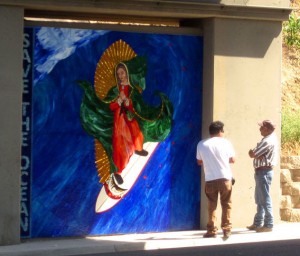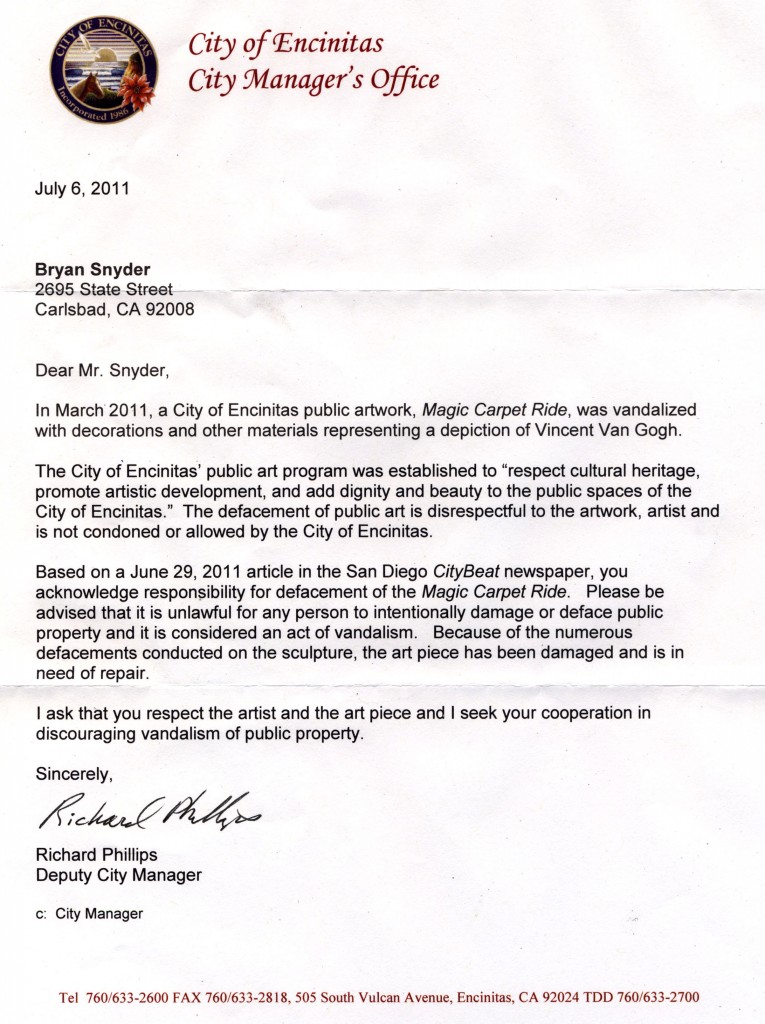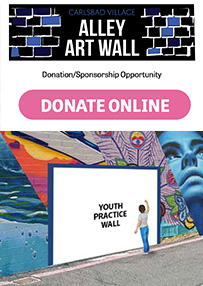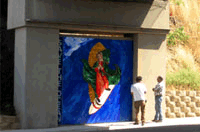 The Magic Carpet Ride or more commonly referred to as the ‘Cardiff Kook’, has been the target of numerous reworkings. It has been dressed up as cupid, eaten by a shark, outed the Encinitas City Council as a propaganda yielding ‘Surfing Madonna’ and, as referenced in the above letter the Encinitas Deputy City Manager, dressed as Vincent Van Gogh.
The Magic Carpet Ride or more commonly referred to as the ‘Cardiff Kook’, has been the target of numerous reworkings. It has been dressed up as cupid, eaten by a shark, outed the Encinitas City Council as a propaganda yielding ‘Surfing Madonna’ and, as referenced in the above letter the Encinitas Deputy City Manager, dressed as Vincent Van Gogh.
 In the letter sent to Snyder Art referring to the transforming of the Kook into Van Gogh, Richard Phillips proclaims that the statue was vandalized. As seen in a series of photos documenting the techniques and materials used during the installation, no adhesive or paint of any sort were affixed to the statue. All props were hung or attached by non-evasive wire with the purpose of eliminating all chances of damage and easy removal.
In the letter sent to Snyder Art referring to the transforming of the Kook into Van Gogh, Richard Phillips proclaims that the statue was vandalized. As seen in a series of photos documenting the techniques and materials used during the installation, no adhesive or paint of any sort were affixed to the statue. All props were hung or attached by non-evasive wire with the purpose of eliminating all chances of damage and easy removal.
 Phillips continues to inform the public art program was established to “respect cultural heritage, promote artistic development and add dignity and beauty to public spaces of the city of Encinitas. Is it wrong to credit the Kook and all its creative, imaginative and widely supported reworkings for not only abiding within the city objectives, but also advocating them. Each installation is a commentary on local and national current and cultural events. It has promoted a slew of artistic installations and it continues to encourage the development of a more artistic community. Most importantly, it has transformed a public art embarrassment into something enjoyed, applauded and sought.
Phillips continues to inform the public art program was established to “respect cultural heritage, promote artistic development and add dignity and beauty to public spaces of the city of Encinitas. Is it wrong to credit the Kook and all its creative, imaginative and widely supported reworkings for not only abiding within the city objectives, but also advocating them. Each installation is a commentary on local and national current and cultural events. It has promoted a slew of artistic installations and it continues to encourage the development of a more artistic community. Most importantly, it has transformed a public art embarrassment into something enjoyed, applauded and sought.
Phillips also emphasizes that it is “unlawful for any person to intentionally damage or deface public property and it is considered an act of vandalism”, but at the same time the city has gone on record claiming it “does not officially condone dressing up the statue, [but] it allows it to happen so long as it is not malicious.”
 If the above quote isn’t proof that street art that is beneficial to a given community needs to be extracted from the definition of vandalism, what is? Even the city council of Encinitas, home of the ‘Cardiff Kook’ sculpture and the city-council-deemed-vandalism ‘Suring Madonna’ mosaic, seems to be confused.
If the above quote isn’t proof that street art that is beneficial to a given community needs to be extracted from the definition of vandalism, what is? Even the city council of Encinitas, home of the ‘Cardiff Kook’ sculpture and the city-council-deemed-vandalism ‘Suring Madonna’ mosaic, seems to be confused.
We are living during the development of art history’s newest art movement. Street and urban public art will be written about in the books future students study from. ‘Exit Through the Gift Shop’, a documentary by the famously anonymous street artist Banksy, was nominated earlier this month for an Oscar. Street projects are showing up in world wide publications almost daily and prestigious museums are dedicating entire spaces to street art exhibits.
With the popularity of street art rapidly increasing and its wide support by the public, city officials are finding themselves stuck between a potential public outcry and an outdated definition. It is time to extract street art from the definition of vandalism!
Bryan Snyder of Snyder Art and Carlsbadcrawl.com proposes the idea of a Sanctioned Street Art Rubric, a detailed grading system that scores a piece of street art in 6 different categories. Each category is worth 10 points. The sum of all category scores (60 point max) will decide whether the piece is sanctioned street art or vandalism, ultimately advising the city/property owner on the future of the piece.
A score of 50 or higher deems it as sanctioned street art.
The Sanctioned Street Art Rubric
1. Aesthetic Artistry – The level of skill in the chosen street art medium. To earn a high score, the piece must exhibit dedication to detail, invested time and thought, mastering of tools and materials and attention to composition and color.
2. Community Acceptance – The acceptance by those who live and visit the area the piece of art is placed in. A high score will only be achieved if the community approves of the art and discloses pleasure in seeing it each day. This is measured through a number of media outlet discussions including newspaper, news television, websites, blogs and on site interviews.
3. Level of Offensiveness – The amount of offended local and visiting members of the community. This includes any negative reaction stemming from the piece’s content. It is scored with all moral, religious, racial, political and social economical beliefs in mind.
4. Relevance to Location – The natural blending of the piece of art into the environment. This includes visually as well as conceptually. A high score will result in a natural fit to the eye and a message that pertains to the feel of the community.
5. Public Safety – The potential harm or level of distraction added to the community due to the piece of art. This includes unsafe installation, potential traffic interference due to material surface or glare, traffic congestion due to onlookers and possible collapsing of the piece. Weather conditions common in the area are also considered.
6. Cost of Removal – The cost incurred by the property owner or city due to the removal of a sub score piece of street art. This includes manpower and potential repair to the surface or environment that the art is place on/in. A high score in this category will result in a piece with easy removal. A low score may be increased with an artist agreement to personally remove art or pay for the removal if deemed vandalism.
Click HERE to see how the Surfing Madonna scored!









Recent Comments